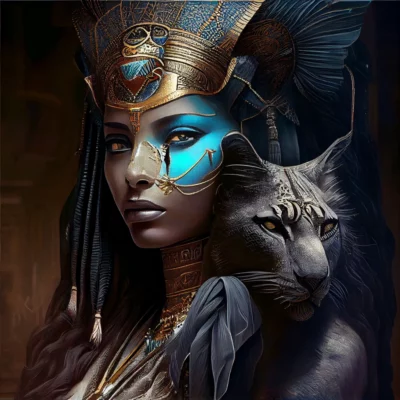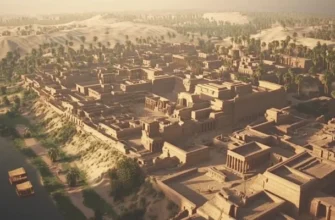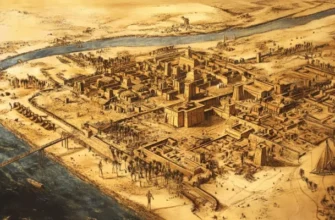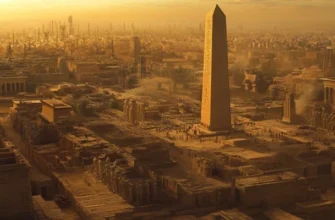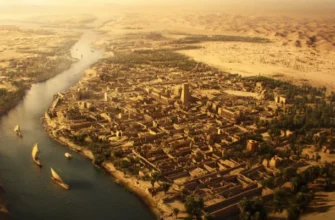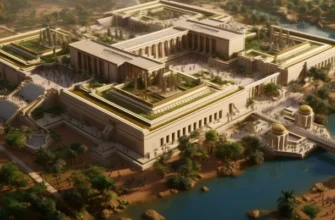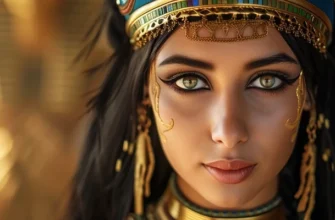The Egyptian goddess Sekhmet is one of the most famous goddesses of ancient Egypt, associated with war and healing. Her iconic images reflected strength and feminine beauty, and her symbols were a lion and a palette knife. The role of Sekhmet in ancient Egyptian mythology was to protect the state and military success, as well as to heal and prevent disease. Today, the cult of Sekhmet is a subject of archaeological research and study in Egyptology, and her images and symbols are used in contemporary culture and art.
- Who is Sekhmet?
- Cult and symbolism of Sekhmet
- Lion and palette knife: associations with Sekhmet in Egyptian mythology
- Sekhmet: the goddess of war and healing
- Sekhmet’s role in medicine and defense of the ancient Egyptian state
- Places of worship and rituals dedicated to Sekhmet
- Temples of Sekhmet: famous religious buildings
- Rites and sacrifices of Sekhmet devotees
- Modern research and heritage of Sekhmet
- Reflections of Sekhmet in contemporary culture and art
- Archaeological research and excavations related to the cult of Sekhmet
- Preservation and restoration of the cult heritage of Sekhmet
- Conclusion.
Who is Sekhmet?
Sekhmet was an Egyptian goddess who was considered the goddess of war, healing, and disease prevention. Her name means “She who loves blood” or “She who loves beer”. She was depicted as a woman with a lion’s head and wore a sun on her head, symbolizing her power over the sky. In addition, she was often associated with Mastikin, the god of darkness and chaos. In ancient Egypt, Sekhmet was an important goddess, and her cult was revered in many cities and towns.
Cult and symbolism of Sekhmet
The cult of Sekhmet in ancient Egypt was associated with war, healing, and the protection of the state. Her image was usually depicted as a woman with a lion’s head, carrying the sun on her head. The symbols of the goddess were a lion, a palette knife, the sun, and medicine. The lion symbolized strength and power, and the palette knife symbolized protection from disease. The sun indicated Sekhmet’s power over the sky, and the medicine indicated her power over healing and health. Many images of Sekhmet contained details reminiscent of bloodshed, reflecting her power and divinity. In ancient Egyptian mythology, Sekhmet was associated with various aspects of life and death, but always played an important role in protecting the state and the people.
Lion and palette knife: associations with Sekhmet in Egyptian mythology
The lion and the palette knife are two important symbols associated with the goddess Sekhmet in ancient Egyptian mythology. The lion symbolized strength and power, which reflected the character of Sekhmet as a goddess of war. The mastiff symbolized healing and protection from disease, reflecting her power as the goddess of healing. In ancient Egyptian mythology, Sekhmet was a lioness goddess who protected the pharaoh and his people from enemies. On the other hand, she was also associated with Mastiqin, the god of darkness and chaos, which symbolized her power over death and disease. All of these symbols and associations portrayed Sekhmet as a powerful divine force, possessing strength and wisdom in the fight against evil and chaos.
Sekhmet: the goddess of war and healing
Sekhmet was an ancient Egyptian goddess who was considered the protector of the pharaohs and the people, as well as the goddess of war and healing. She was depicted as a woman with the head of a lion, carrying the sun on her head. The lion symbolized strength and power, and the palette knife, which was also associated with Sekhmet, represented protection from disease. The sun indicated Sekhmet’s power over the sky, and the medicine indicated her power over healing and health. In ancient times, Sekhmet was considered the protector of the army and military strategy. At the same time, she was also associated with healing, helping people to cure diseases. The goddess Sekhmet was considered one of the most powerful divine forces in ancient Egypt and occupied an important place in the religious and cultural heritage of this country.
Sekhmet’s role in medicine and defense of the ancient Egyptian state
In ancient Egypt, Sekhmet played an important role as the goddess of healing and protection. She was considered the patroness of doctors and medicine, and her symbols were used to treat various diseases. Many medical knowledge and practices were associated with the cult of Sekhmet, and doctors wore amulets with her image, which they believed would help them in their work.
In addition, Sekhmet was considered to be the protector of the pharaohs and the people from their enemies. With the help of her warriors and her military strategy, she ensured the protection of the state from enemy attacks. She was depicted with weapons and a shield, symbolizing her power and strength.
Thus, Sekhmet’s role in medicine and defense of the ancient Egyptian state was very important, and she was considered one of the most important goddesses in the Egyptian pantheon.
Places of worship and rituals dedicated to Sekhmet
In ancient Egypt, there were many places of worship dedicated to the goddess Sekhmet. One of the most famous is the temple of Sekhmet in Memphis, where her main shrine was located. Other important temples of Sekhmet were located in Karnak, Luxor, and Todi.
Rites dedicated to Sekhmet were often associated with the celebration of the new year and other important events. On these days, various religious ceremonies and rituals were held to ensure the protection of the state and the people from dangers. Healing rites were also performed, during which Sekhmet was asked for blessings and healing.
One of the most famous rituals was the “festival of fire” that took place in Karnak to mark the transition to the new year. On this day, priests would place candles and torches on the ground to represent the light that leads to victory over darkness and evil forces.
Also, Sekhmet was often depicted on amulets and other amulets worn by believers to receive her protection and blessings.
Temples of Sekhmet: famous religious buildings
In ancient Egypt, there were many temples dedicated to the goddess Sekhmet. One of the most famous temples was the Temple of Sekhmet in Memphis, which was founded in the Ancient Kingdom and was an important place of worship throughout the entire period of the state’s existence.
The Temple of Sekhmet in Memphis was one of the largest and most important temples in the state. It consisted of numerous shrines in which religious rites and sacrifices were performed.
In addition to the Temple of Sekhmet in Memphis, the goddess also had her temples in other major cities in Egypt, such as Karnak, Luxor, and Theni. These temples were also important places of worship and attracted many pilgrims.
Various religious rites and ceremonies were held in the temples of Sekhmet, aimed at glorifying the goddess and receiving her blessings and protection. The temples also served as a place of storage for shrines and artifacts related to the cult of the goddess Sekhmet.
Rites and sacrifices of Sekhmet devotees
Sekhmet is an Egyptian goddess who symbolizes power, war, healing, and destruction. In ancient Egyptian mythology, she was often depicted as a lioness with a human head, and her cult was very popular in Egypt. The rituals and sacrifices associated with the goddess Sekhmet were intended to ask for her protection, as well as to ask for restoration of health and protection from disease.
One of the most famous rituals associated with Sekhmet was the festival of Maget, an annual festival that took place at the goddess’ temple in Memphis. During this festival, various ceremonies were held, including martial arts demonstrations and music performances. Sacrifices were also made, including live cattle, birds, and other foods.
Other rites associated with Sekhmet were various medical ceremonies. Priestly doctors used magical words and incantations to heal the sick, and also performed sacrifices to appease the goddess’s anger and provide protection from disease.
Another famous ritual associated with Sekhmet was the dance of the crimson lion. This ritual took place in the temples of the goddess and was intended to pay homage to Sekhmet and invite her protection. In this rite, the priests used a special costume depicting a lioness and performed special dance moves to music.
Modern research and heritage of Sekhmet
Sekhmet is a goddess in Egyptian mythology who symbolizes female power, warfare, and medicine. She was depicted as a woman with a lion’s head and usually acted as the pharaoh’s protector and divine physician.
Today, researchers continue to study Sekhmet and her legacy. For example, they explore her role in the culture and religion of ancient Egypt, as well as her influence on modern cultures.
Some research also focuses on archaeological findings related to Sekhmet. For example, in 2017, a statue of Sekhmet was found in the Temple of Mut in Luxor, dating from 1390-1352 B.C. This statue is one of the oldest known depictions of the goddess.
Sekhmet also has a great cultural influence on modern times. She is an object of study and admiration in scientific and artistic circles, and has become a popular character in books and films about ancient Egypt.
All of this allows us to better understand and appreciate the legacy of Sekhmet and her importance to the culture and religion of ancient Egypt, as well as her influence on our modern world.
Reflections of Sekhmet in contemporary culture and art
Sekhmet is a goddess in Egyptian mythology who represented strength and power. In contemporary culture and art, the image of Sekhmet can be found in various forms and shades.
One example of the use of the image of Sekhmet can be found in movies and television series, where she is portrayed as a powerful goddess with great strength and power. For example, in the movie The Mummy from 1999, Sekhmet is depicted as a killing tool left over from the era of the pharaohs. The television series “Stargate SG-1” also refers to Sekhmet as one of the goddesses in Egyptian mythology.
In the music industry, the image of Sekhmet can also be found as a symbol of strength and power. For example, the American singer Beyoncé uses the image of Sekhmet in her performances and music videos, which reinforces her image of a strong and independent woman.
The image of Sekhmet can also be found in traditional art forms such as painting and sculpture. For example, the American Metropolitan Museum of Art in New York has a collection of Sekhmet sculptures that date back to 1390-1352 BC. These sculptures depict a goddess with lion ears and a head that is adorned with a necklace.
Thus, the image of Sekhmet is well-known and used in modern culture and art, which reinforces the image of strength and power.
Archaeological research and excavations related to the cult of Sekhmet
Archaeological research and excavations are related to the cult of Sekhmet, which was very common in ancient Egypt. The cult of Sekhmet was associated with the lion, which was the symbol of this goddess, so many of the findings associated with this cult are related to lions.
One example of archaeological excavations related to the cult of Sekhmet is the excavations at the goddess’s temple in Karnak. This temple was founded around 2000 BC and is dedicated to the cult of Sekhmet. During the excavations, many statues of Sekhmet and other gods were found, as well as tools used to perform rituals.
Another example is the excavations carried out in Abydos, where several temples dedicated to Sekhmet were found. Statues, images, and other artifacts related to the cult of Sekhmet were found in these temples.
In addition, other places have excavations related to the cult of Sekhmet, such as Naga Hammadi and Dendera, where various artifacts related to this goddess have been found.
Thus, archaeological research and excavations allow us to learn more about the cult of Sekhmet and other aspects of Ancient Egypt. Finds made during excavations help to expand our historical information about the cult practices and religious beliefs of the people who lived at that time.
Preservation and restoration of the cult heritage of Sekhmet
The preservation and restoration of the cultic heritage of Sekhmet is an important task for the preservation of the historical and cultural heritage of Ancient Egypt. Various approaches and tools are used to achieve this goal.
One way to preserve the cultic heritage of Sekhmet is to preserve and restore artifacts associated with this goddess. This may include the restoration of statues, images, and other artifacts that have been found during archaeological research. In addition, modern technologies such as 3D scanning and printing can be used to recreate lost artifacts and preserve them for future generations.
Another way to preserve the cultic heritage of Sekhmet is to conduct excavations and research that allow us to learn more about this cult and other aspects of Ancient Egypt. This can include excavations at sites associated with the cult of Sekhmet, such as temples and pyramids, as well as the use of the latest technology to study artifacts.
In addition, in order to preserve the cult heritage of Sekhmet, it is important to maintain and promote interest in the culture of Ancient Egypt among the general public. This can be achieved by holding exhibitions, lectures, and other events that showcase the cultural heritage and religious traditions of Ancient Egypt.
Conclusion.
In ancient Egyptian mythology, Sekhmet played an important role as the goddess of death, war, and medicine. Her image was often depicted as a female figure with a lion’s head, symbolizing her power and strength. She was also associated with many religious centers in different parts of Ancient Egypt.
Today, Sekhmet is an important part of Ancient Egypt’s cultural heritage and continues to influence contemporary culture and art. Her image is used in movies and literature to create an image of a strong and powerful woman. In addition, images of Sekhmet can be seen at various art exhibitions, as well as in museums dedicated to the culture and history of Ancient Egypt.
Preserving and restoring the cult heritage of Sekhmet is an important task for preserving the historical and cultural heritage of Ancient Egypt. To achieve this goal, a variety of approaches and tools are used, including the preservation and restoration of artifacts, excavations and research, and the support and promotion of interest in Ancient Egyptian culture among the general public. Thus, Sekhmet’s role in ancient Egyptian mythology and her legacy continue to live on and influence our world in modern times.
